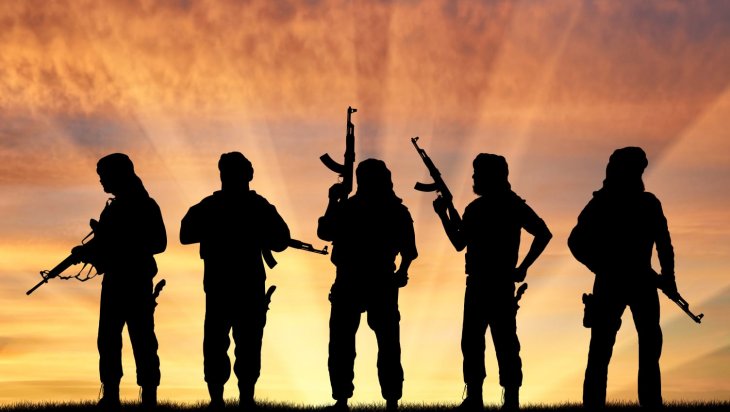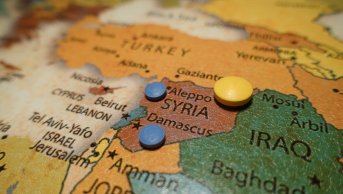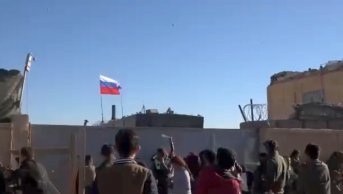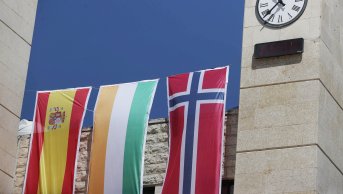Is ISIS Being Revived by the YPG in Syria?

Thousands, if not more, of ISIS members and their families who are held in camps and prisons in the region under the terrorist organization YPG/PKK’s (People's Protection Units/ Kurdistan Workers Party) control in the northeast of Syria, are being released. The Syrian Democratic Council, which is the political arm of the YPG, announced on October 5, 2020 that 25,000 Syrians held in the Hol Camp will be released as a part of the general amnesty.1 Some ISIS members and families are also among the released prisoners. The statement claimed that, “the people that were released had not been involved in armed conflicts, did not have blood on their hands and were remorseful for being a part of ISIS”. However, despite losing physical ground, it is true that ISIS is still ideologically strong in the country. It is also true that ISIS has increased the number of its attacks in Syria in 2020. It is highly likely that the ISIS members that are now being released will pose a potential threat to Syria, Turkey and EU countries.
The representatives of the so-called autonomous administration that was declared unilaterally by the PYD/YPD, announced that 631 Syrians held in a camp in Qamishli were released on the 15th of October and the penalties of 253 people that are still detained, will be reduced by half within the scope of the general amnesty.2 It was reported that the YPG also released 70 families from the Hol Camp on October 19, 2020, which represented 290 people in total.3 Recently, it was confirmed that 35 families held in the Hol Camp were also released, after leaders of the Arab tribes in Raqqa vouched for them.4 Released people were delivered to the ‘Raqqa Civil Council’, which was established in Raqqa on April 19, 2017 to manage administrative affairs.
There are more than twenty prisons, and more than ten official and non-official refugee camps in the YPG-controlled area. In addition to Syrian refugees that fled the armed conflicts, ISIS members and their families stay in the Hol and Roj camps, which are the biggest camps in the region. There are close to 10,000 ISIS militants in prisons and detention centers controlled by the YPG.5 However the terror group refuses to release the exact numbers. Two thousand of them are foreign terrorist fighters (FTF) that are not accepted by their own countries. It is reported that there are close to 2000 FTF’s in the Hol Camp from 50 different countries in addition to numerous Syrian and Iraqi terrorists. It was stated that amnesties were granted in line with the requests of the tribal leaders in the Northeast and Eastern Syria. Prior to the releases, there had been reports of a general amnesty plan since the camps were overcrowded. It is possible that the process was sped up due to the spreading coronavirus pandemic.
Halid Devriş, the German Representative of the so-called autonomous region gave an interview after the releases and said that “larger groups would be released in the coming days”. About the possibility of this decision leading to the creation of a threat in and outside the country in the future, Devriş said that “the people that were released had ISIS ideology, but were not observed to have radicalization tendencies in the camp and it is impossible to make any guarantees for the future”.6 Prisoners in YPG-controlled camps and prisons, however, have to live in the same difficult conditions as the ISIS families. Particularly the Hol Camp hosts close to 73.000 people,7 31,000 Iraqis and 10,000 from different countries8 and is rightly called the ‘ISIS hotbed’. It is known that since the YPG is lacking in its efforts to rule the region, ISIS sympathizers were able to physically build an autonomous structure and sought to indoctrinate teenagers younger than 18 in ISIS ideology. Most notably, the Hol Camp has been used by ISIS as a recruitment area for the new generation. The so-called autonomous administration stated that, at the moment, there is no question of releasing the YTS. The YPG is known to use its ISIS militant captives as leverage against involved countries. It was recently revealed that the YPG refused to deliver more than 25 German citizens who were ISIS members back to German authorities. In the past, there have been many instances where various Western countries were reluctant to take back their ISIS-affiliated citizens, despite the persistent calls of the YPG. The last incident is important in that it shows the conflicted attitude of the YPG.
According to local sources, it is estimated that a total of 6000 people was released from the Hol camp after the Arabic tribes vouched for them. There are only weak assurances that there will be no joining ISIS from among 31,000 people, which includes 25,000 people that are expected to be released as a part of the amnesty. In addition, it is almost impossible for the tribal leaders to control the released people and therefore their assurance cannot be considered enough of a guarantee. It is known that ISIS, which still has an ideological support base, continues its physical existence in the East of Euphrates through its sleeper cells. Therefore, any power vacuum or any steps in the region that might play into the hands of ISIS, can easily make the terror group stronger in the region. And this will work to the advantage of the YPG as the Western world will need the YPG more in its fight against ISIS. It will also help the YPG to gain legitimacy on the international arena. The YPG will use the strengthening profile of ISIS as a means to reinforce its control in the region and also to demand more military and financial support. Therefore, it is possible to say that the YPG seeks to gain a foothold using the fight against ISIS.
The YPG was unable to make concrete progress towards its goal of playing a role in the political solution in Syria and also in its quest to gain legitimacy in the international arena. Negotiations that have been ongoing for the past nine months between the Kurdish National Council of Syria (KNC) and the Democratic Union Party (PYD)/YPG as a part of a quest for legitimacy failed because the YPG did not meet the demands of the KNC. The KNC is seen as the legitimate representative of the Syrian Kurds and they were invited as a party to the negotiations held to find a solution to the Syrian crisis. Syrian Kurds were represented by 2 KNC members in the Constitutional Committee, which is made up of a total of 150 people. The YPG sought to merge with the KNC in order to officially be a part of the constitution efforts, hoping that it would indirectly make it the legitimate representative of the Syrian Kurds. However, the fact that the YPG refused to dismiss its members who are affiliated to the PKK, that it denied the Rojava Peshmerga of the KNC in Northern Iraq any entry to Syria and its failure to implement other previously accepted political agreements, led to the failure of the negotiations between the parties. In addition, there have been armed conflicts between the YPG and Arabic tribes in Deir ez-Zur. The YPG might seek to use ISIS as leverage to stop the increasing domestic political pressure. It is possible to expect that released potential ISIS members will go to Deir ez-Zur and support the increasing ISIS activities there. The ISIS presence in the region will move away from YPG-controlled areas and will turn into more of a security threat in mostly Arabic tribal regions. This will lead to Arabic tribes needing the YPG more for protection.
Tens of thousands of people held in camps and prisons in the northeast of Syria tend to become radicalized as they have been deprived of basic needs and mismanaged and oppressed. The YPG uses these people as leverage and does not shy away from using these people to its advantage when the time comes. People and their families who embrace the ISIS ideology, share the same environment with other refugees and therefore everyone is seen as a potential threat. Since the beginning of October, the YPG has begun to release people who are potentially dangerous after tribes vouched for them. However, it is unknown how these people will behave in the future. In case of an administrational change in the USA, it is possible that the USA will choose to remain for some more time in eastern Syria. An ISIS threat that will be built via the YPG can present the necessary conditions for this policy.
Endnotes
1 Campbell MacDiarmid, “Syrian Kurdish authorities to free 25,000 Syrians from camp for Islamic State supporters”, The Telegraph, 5 October 2020, https://www.telegraph.co.uk/news/2020/10/05/syrian-kurdish-authorities-free-5000-syrians-camp-islamic-state/.
2 “631 ISIS Suspects Released From East Euphrates Prisons”, The Nation Press, 16 October 2020, https://thenationpress.net/en/news-71675.html.
3 Zehra Nur Duz, “YPG/PKK releases Daesh/ISIS terrorists in NE Syria”, Anadolu Ajansı, 19 Ekim 2020, https://www.aa.com.tr/en/middle-east/ypg-pkk-releases-daesh-isis-terrorists-in-ne-syria/2011548.
4 “Syria Al Hol Camp to Release 35 Displaced Syrian Families following Tribal guarantees”, A24 Agency News, 29 October 2020, https://www.a24na.com/portal/index.php/doc1/year2018/month10/24769-syria-al-hol-camp-to-release-35-displaced-syrian-families-following-tribal-guarantees/.
5 “YPG/PKK releases Daesh/ISIS terrorists in NE Syria”, Anadolu Agency, 6 January 2020, https://www.aa.com.tr/en/middle-east/ypg-pkk-releases-daesh-isis-terrorists-in-ne-syria/1693698.
6 “Suriye'de serbest kalan IŞİD'liler Tehlike Oluşturuyor Mu”, Deutsche Welle (DW) Türkiye, 17 Ekim 2020, https://www.dw.com/tr/serbest-b%C4%B1rak%C4%B1lan-i%C5%9Fidliler-tehlike-olu%C5%9Fturuyor-mu/a-55307856.
7 Aaron Y. Zelin, "Wilayat al-Hawl: Remaining’ and Incubating the Next Islamic State Generation", The Washington Institute For Near East Policy, October 2019 p.3, https://www.washingtoninstitute.org/uploads/Documents/pubs/PolicyNote70-Zelin.pdf.
8 Eva Kahan “ISIS Poised to Exploit Mass Releases of Displaced Persons from Syrian Camp”, 14 October 2020, Institute For The Study Of War, http://www.understandingwar.org/backgrounder/isis-poised-exploit-mass-releases-displaced-persons-syrian-camp#:~:text=%5B8%5D%20As%20of%20September%202019,camp%20was%20built%20to%20sustain.




